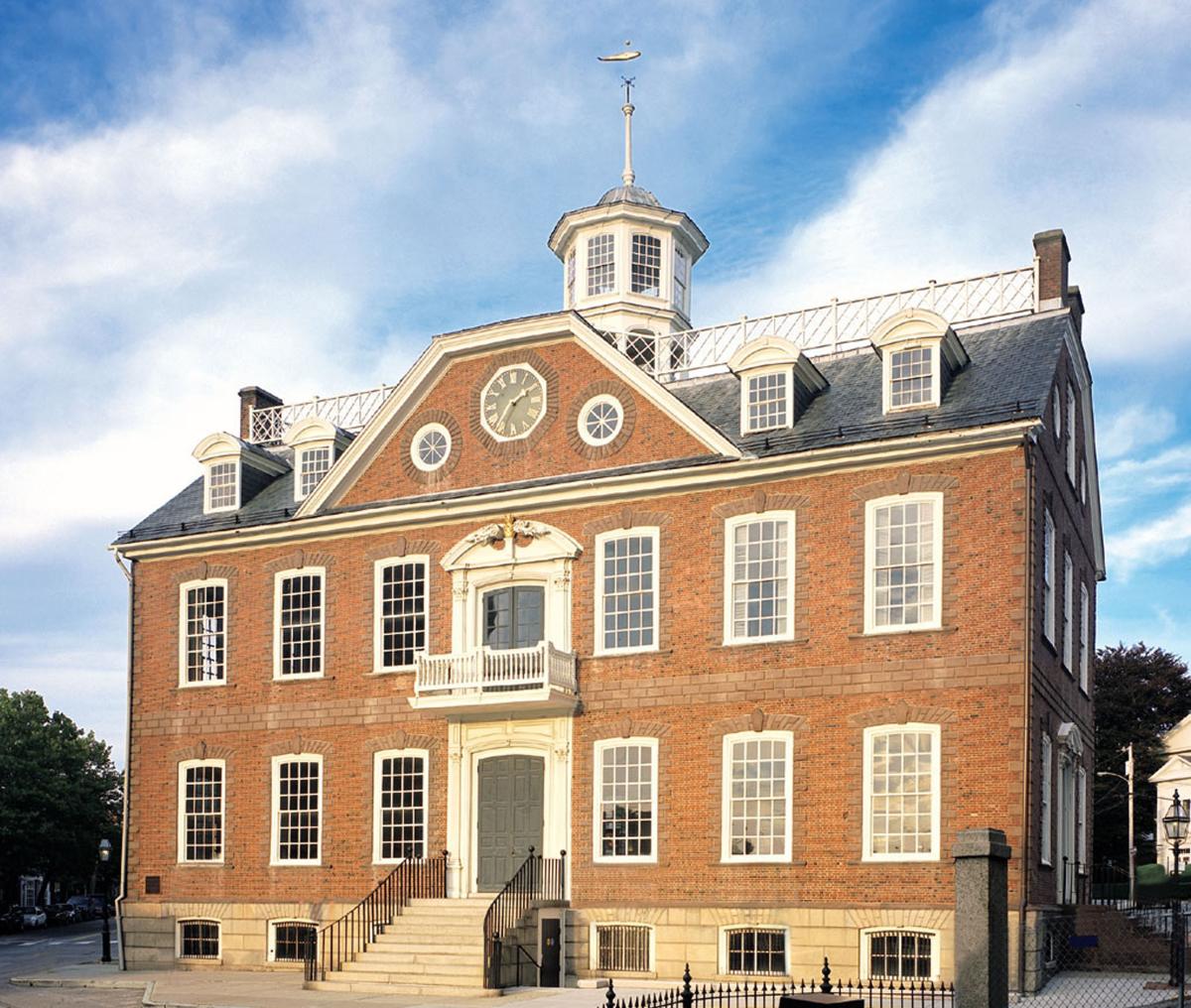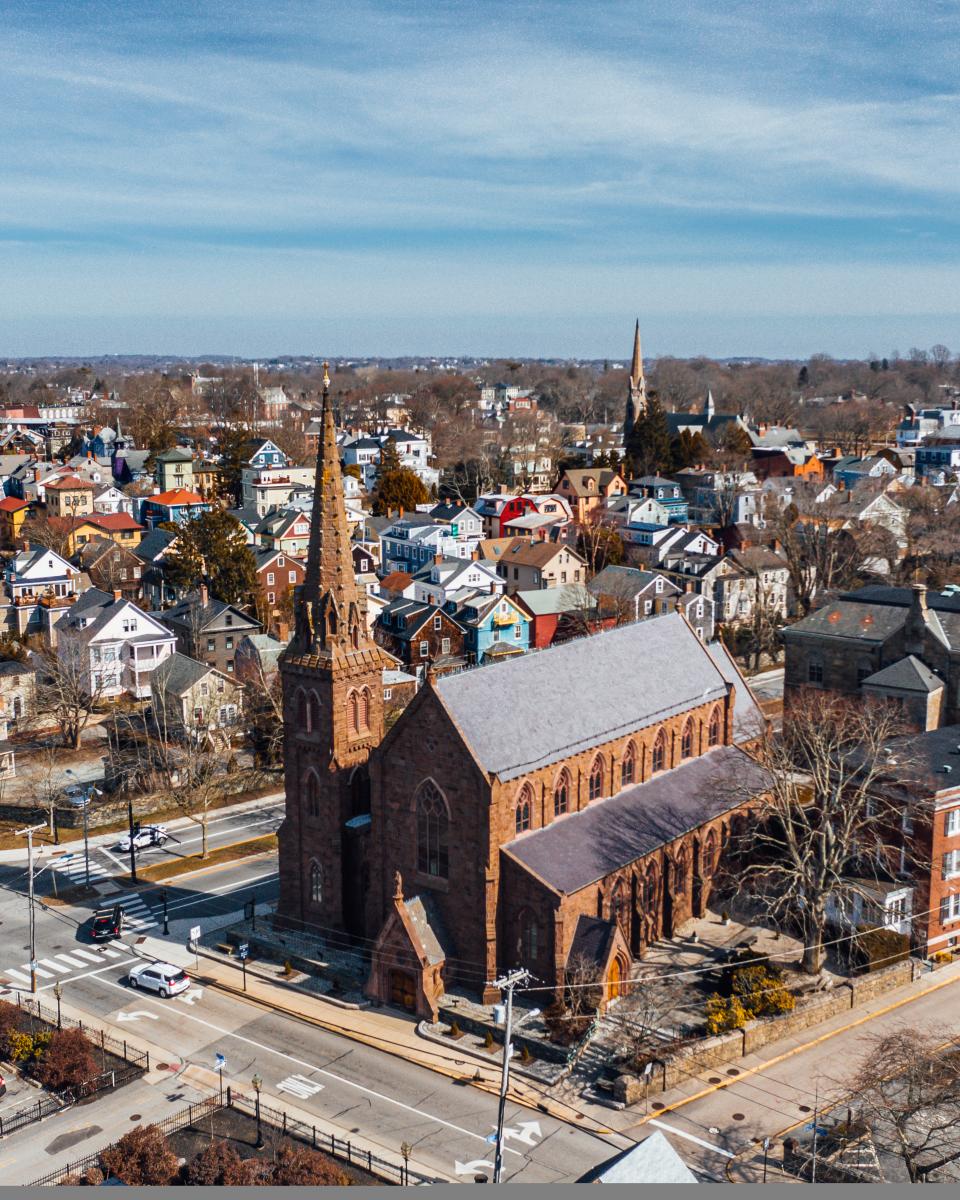Nearly four hundred years of history lingers around every corner in Newport. Walk these cobblestone byways and pass by the oldest synagogue in the country, or transport back to the 17th century when you step foot in America's oldest tavern. When you walk these streets, roam these hallways and explore this coastline, its 1639, and 1892 and 2023.
Below are 10 of the oldest, most historic spots in Newport.
White Horse Tavern
Back to Top of ListOpened in 1673, White Horse Tavern feels somewhat frozen in time; rooms are still lit with oil lamps, logs burn in the fireplaces and cozy candles still set the mood. Not to mention, its exterior maintains its distinctly Colonial clapboard walls and gambrel roof. For more than 100 years, the building served as the meeting place of the colony's General Assembly, Criminal Court, and City Council. Today, you'll find a seasonal menu of classics with a modern twist, all alongside cavernous fireplaces and some tales of haunted history.
Newport Colony House
Back to Top of ListBuilt between 1736 and 1739, Newport Colony House is the fourth oldest statehouse still standing in the United States and a designated National Historic Landmark. According to the Newport Historical Society, it was originally constructed as part of the movement to bring formal town planning to Newport, which until then had developed in haphazard fashion. Intentions at the time were to transform the Parade, the gathering space we know today as Washington Square, into an elegant public space in keeping with the traditions of English cities.
The building itself, derived from the English Georgian style, is often associated with a lengthy list events that played an important role in shaping the United States. In 1766, citizens of Newport celebrated the repeal of the Stamp Act here; years later on July 20, 1776, Major John Handy read the Declaration of Independence from the front steps of this historic building. During the British occupation of Newport from 1776 to 1779, the Colony House was used as a barracks. Not to mention, the building served as the primary state house of Rhode Island and Providence Plantations from 1739 until 1901, when the new state house in Providence opened.

Touro Synagogue
Back to Top of ListBuilt in 1763, Touro Synagogue is the oldest synagogue building still standing in the United States, the oldest surviving Jewish synagogue building in North America and the only surviving synagogue building in the U.S. dating to the colonial era. The interior boasts a series of twelve Ionic columns each carved from a single tree, which signify the twelve tribes of ancient Israel. The building faces east toward Jerusalem and still operates as a functioning house of worship, so make sure to time your visit and tour accordingly.
Great Friends Meeting House
Back to Top of ListThe Great Friends Meeting House, built in 1699, is the oldest surviving house of worship in Rhode Island. The building served as the meeting place for the Religious Society of Friends (Quakers), who largely controlled the culture and politics of Newport in the 17th and 18th centuries, with many residing in the nearby historic Point Neighborhood. Today, the building maintains its wide-plank floors, plain benches and beam ceiling.

St. Mary's Church
Back to Top of ListHome to Rhode Island’s oldest Roman Catholic parish, (built in 1848) is also the place where John F. Kennedy and Jackie Bouvier said I do on September 12, 1953. The two wed at St. Mary's Church before 600 friends, family, diplomats, and senators, while outside, 2,000 society fans waited to greet the new Mr. and Mrs. Kennedy. Prior to that memorable date, St Mary's served as the chapel for the Naval Academy during the Civil War from 1861 - 1865 after it relocated from Annapolis Maryland to Bellevue Avenue.

Old Stone Tower
Back to Top of ListLocated in Touro Park for at least 350 years, the Old Stone Mill Tower has been the center of much debate in Newport. To this day, its origins remain as mysterious as its intended use with theories ranging far and wild (err, wide). The most accepted of these seems to be that Benedict Arnold built the tower as part of a windmill in the mid-1600s, leading to its common local nickname, the Old Stone Mill. In his will, Benedict referred to “my old stone mill.” While a logical theory, people still question why it doesn't look like other windmills built at that time. Other theories include that it was built by Vikings (which might explain why the sports teams of Rogers High School are called the Vikings.)
Redwood Library
Back to Top of ListThe Redwood Library was established in 1747 by Abraham Redwood and 45 colonists looking to make written knowledge more available. During the revolutionary war, the library was used as an officer's club for the British army. Unfortunately, during the war, many of the books went missing until 1947 when a concentrated effort was made to replace the editions of the original collection as closely as possible.
Today, the library houses 92% of the volumes that were originally lost. Make your way through the Roman Doric-inspired entrance to explore the library's extensive collection alongside two revolving galleries, paintings, busts, sculptures, decorative arts, and more.
Trinity Church
Back to Top of ListTrinity Church located in Queen Anne Square has a long history of worship, dating back nearly 300 years to 1726 when the church was originally built. It has since served as the place of worship for George Washington (commemorated by a plaque placed in his favorite pew), Queen Elizabeth II, Prince Andrew, and Archbishop Desmond Tutu and his wife Leah—to name a few. It has also serviced as the filming location for a number of prominent films including Wes Anderson's Moonrise Kingdom,Steven Spielberg's Amistad and Lajos Koltai's Evening. Today, Trinity remains home to the only center-aisle, freestanding, triple-decked pulpit left in America.
Wanton-Lyman-Hazard House
Back to Top of ListThe oldest surviving house in Newport, the Wanton-Lyman-Hazard House was built for Stephen Mumford in 1697. Originally built with a single room on each side of a central chimney, the house grew with each generation of owners, with a lean-to kitchen built at the northeast end of the house sometime before 1725. The Lyman family, which needed more room as it grew to include thirteen children, added a large two-story addition to the rear of the house about 1785. Today, the house is owned and operated by the Newport Historical Society.

Vernon House
Back to Top of ListConstruction of the 2 1/2-story William Vernon House located on the corner of Clarke and Mary streets dates back to the late 17th century. A prominent example of Georgian architecture, Vernon House is one of Newport's last grand merchant's houses, and played host to many notable guests during Vernon's ownership. During the American Revolutionary War, it served as the headquarters of General Rochambeau, commander of the French forces stationed in Newport.
you may also like
GET SOCIAL
Tag your photos #TheClassicCoast for the chance to be featured on our accounts.























